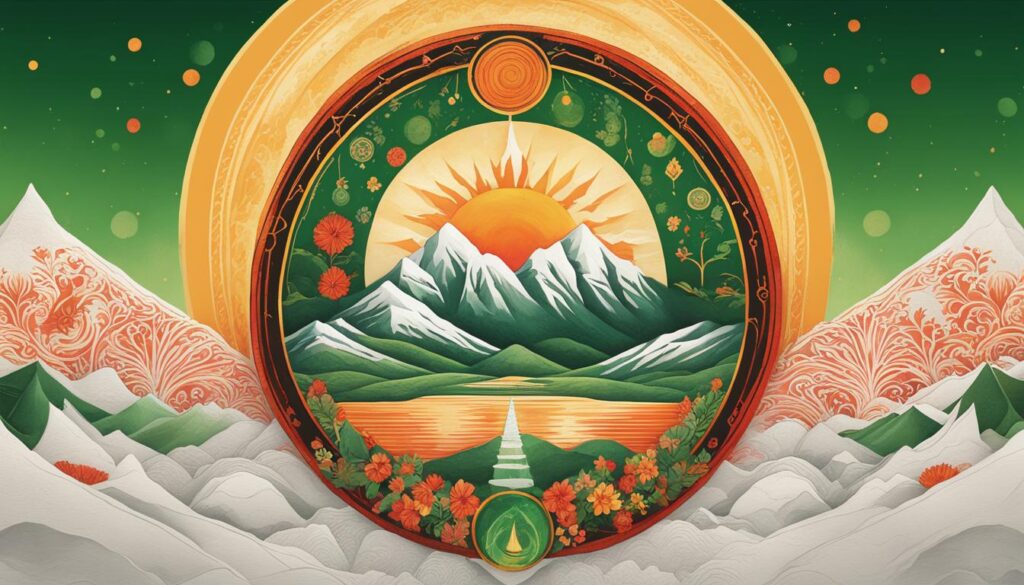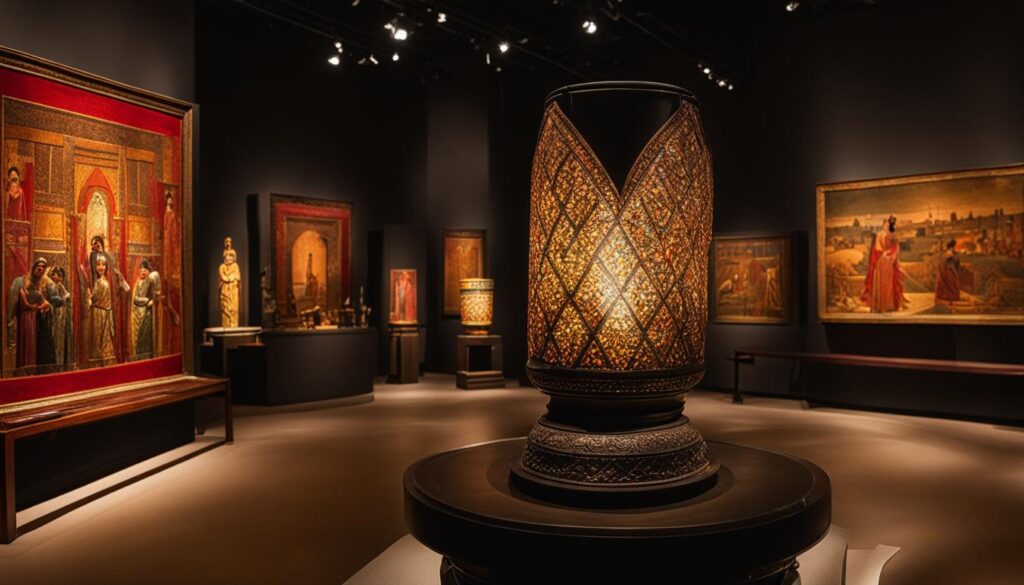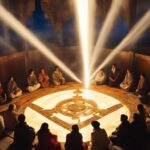Zoroastrianism, one of the oldest religions in the world, has a rich cultural heritage that continues to captivate and inspire. With customs, rituals, and beliefs dating back over 3,000 years, Zoroastrianism offers a unique glimpse into ancient practices and profound spiritual teachings. In this article, we will delve into the vibrant traditions and practices of Zoroastrianism and explore its enduring impact on the world.
Key Takeaways:
- Zoroastrianism is one of the most ancient religions in the world
- It has relatively small global adherents, estimated at 125,000
- Zoroastrianism was founded by the prophet Zoroaster over 3,000 years ago
- Its core beliefs center around the constant battle between good and evil
- Zoroastrian culture is rich with customs and traditions
A Brief History of Zoroastrianism
Zoroastrianism is one of the world’s most ancient religions, founded by the prophet Zoroaster, also known as Zarathustra, over 3,000 years ago. Its exact origins and early history are uncertain, but it predates major world religions like Christianity and Islam. Zoroastrianism became the dominant religion in ancient Persia, influencing the culture and tradition of the region.
“The purpose of life for a man is to increase the number of the faithful. ‘Good Thoughts, Good Words, Good Deeds’ is the foundation of Zoroastrian ethics.”
– Quote attributed to Prophet Zoroaster
In the 7th century, Arab Muslims conquered Persia, leading to the decline of Zoroastrianism in the region. Many Zoroastrians migrated to western India, where they formed the Parsi community. The Parsis embraced the teachings of Zoroaster and established thriving communities. Today, they are the largest Zoroastrian community in the world.
The migration of Zoroastrians to India not only preserved the faith but also allowed it to influence Indian culture and society. The Parsis played a significant role in various fields, including business, philanthropy, and the arts. Their contributions continue to be celebrated and admired.
Despite its ancient origins, Zoroastrianism remains a vibrant and influential faith. Its teachings of good thoughts, good words, and good deeds have had a profound impact on other major religions. The faith’s resilience and enduring legacy are showcased in events like The Everlasting Flame Exhibition, which tells the story of Zoroastrianism through artifacts, manuscripts, and installations.
| Key Events in Zoroastrian History | Year |
|---|---|
| Prophet Zoroaster’s Birth | 628 BCE |
| Founding of Zoroastrianism | 600 BCE |
| Arab Muslim Conquest of Persia | 7th century CE |
| Parsi Migration to India | 8th-10th century CE |
| The Everlasting Flame Exhibition | 2008 CE |
Core Beliefs of Zoroastrianism
Zoroastrianism, an ancient religion with a rich history, is characterized by its core beliefs that center around the eternal struggle between good and evil. At the heart of Zoroastrianism is the belief in a supreme deity known as Ahura Mazda, who represents the forces of good. Followers of this faith are called to align their actions and choices with goodness and righteousness, while actively fighting against evil.
The concept of dualism is a fundamental aspect of Zoroastrianism. It teaches that the world is divided into two opposing forces: Spenta Mainyu (the Beneficent Spirit) and Angra Mainyu (the Destructive Spirit). These two forces, representing good and evil, continuously clash, engaging in an eternal battle. Zoroastrians believe that the ultimate triumph of good over evil is inevitable, and they strive to contribute to the victory of light over darkness.
Ahura Mazda is regarded as the creator of all things and the source of divine wisdom and truth. Zoroastrians believe in the importance of living a virtuous life and following a moral code to align themselves with Ahura Mazda’s divine plan. They believe in the power of individual choice and free will, emphasizing that each person is responsible for their actions and will face the consequences, whether they choose good or evil.
The Battle Between Good and Evil
“There is no path that leads to evil. Evil resides where there is no good.” – Zarathustra
Zoroastrianism’s teachings on good and evil have had a profound influence on other major religions. The belief in a divine force of goodness and the constant struggle against evil can be seen in the moral teachings of Christianity, Islam, Judaism, and Buddhism. These religions have incorporated aspects of Zoroastrianism’s dualistic worldview into their own theological frameworks, highlighting the enduring significance of Zoroastrian beliefs in shaping human thought and spirituality.

| Key Beliefs of Zoroastrianism | Description |
|---|---|
| Dualistic worldview | Zoroastrianism teaches a constant battle between good and evil forces, with believers urged to align themselves with goodness and fight against evil. |
| Supreme deity – Ahura Mazda | Ahura Mazda is the central figure in Zoroastrianism, representing the forces of good and the source of divine wisdom and truth. |
| Individual responsibility | Zoroastrians believe in the power of individual choice and free will, emphasizing personal responsibility for actions and the consequences that follow. |
| Influence on other major religions | Zoroastrian teachings on good versus evil have influenced the moral teachings and theological frameworks of Christianity, Islam, Judaism, and Buddhism. |
Zoroastrian Customs and Culture
Zoroastrianism is a religion deeply rooted in customs and traditions that have been passed down through generations. These customs play a significant role in the lives of Zoroastrians, shaping their daily routines, celebrations, and interactions with others. From festivals to rituals, Zoroastrian customs are a vibrant reflection of the rich cultural heritage of this ancient faith.
Zoroastrian Festivals and Celebrations
One of the most prominent aspects of Zoroastrian culture is its vibrant festivals and celebrations. These events bring the community together in joyous gatherings to honor various milestones and religious observances. The Nowruz festival, celebrated on the spring equinox, marks the Persian New Year and is widely observed by Zoroastrians and others in regions that were once part of the Persian Empire. During Nowruz, families gather, exchange gifts, and partake in feasts to welcome the new year.
Another significant celebration is the Mehregan festival, which celebrates the divinity of Mithra, the Zoroastrian sun god. Mehregan is a time of thanksgiving and reflection, where families gather for ritual prayers, music, and dance performances. These festivals not only serve as occasions for communal bonding but also provide an opportunity for Zoroastrians to reaffirm their faith and connect with their ancient roots.
Zoroastrian Traditions and Rituals
Zoroastrianism places great importance on maintaining purity and balance in life. As a result, the religion is marked by numerous traditions and rituals that guide followers in their daily lives. One such tradition is the practice of prayer five times a day, known as the Kusti prayer. Zoroastrians also observe the cleanliness of their bodies and surroundings, emphasizing the importance of spiritual and physical purity.
The Navjote ceremony is a significant ritual in Zoroastrianism, marking the initiation of a young person into the faith. During this ceremony, the individual receives the sacred thread, known as the Kusti, and commits to upholding the tenets of Zoroastrianism. The Navjote is a momentous occasion celebrated with family and friends, highlighting the community’s commitment to passing on their religious traditions to the next generation.
Zoroastrian Philanthropy and Entrepreneurship
Zoroastrian culture is also known for its strong emphasis on philanthropy and entrepreneurship. Throughout history, Zoroastrians have been renowned for their generosity and charitable endeavors. Prominent figures like Jamsetji Tata and the Wadia Group have made notable contributions to society, leaving a lasting impact on the fields of business, education, and philanthropy.
The entrepreneurial spirit of the Zoroastrian community can be traced back to its ancient roots. Zoroastrians have a long history of engaging in trade and commerce, enabling them to thrive in various regions of the world. This spirit of enterprise has not only contributed to the economic growth of Zoroastrians but has also fostered a legacy of innovation and success within the community.
Overall, Zoroastrian customs and culture continue to play a vital role in preserving the rich heritage of this ancient faith. Festivals, traditions, and philanthropic endeavors serve as pillars of the Zoroastrian community, reinforcing their strong bonds and commitment to their beliefs.
| Zoroastrian Festivals and Celebrations | Zoroastrian Traditions and Rituals | Zoroastrian Philanthropy and Entrepreneurship |
|---|---|---|
| Nowruz | Kusti prayer | Jamsetji Tata |
| Mehregan | Navjote ceremony | Wadia Group |
Challenges and Future of Zoroastrianism
Zoroastrianism, despite its rich history and cultural significance, has been facing numerous challenges in recent years. The global Zoroastrian community is experiencing a decline in numbers, particularly in India, where the religion has its roots. There are several factors contributing to this trend, including a lack of conversion efforts and strict rules regarding mixed marriages.
The Zoroastrian diaspora, however, paints a more optimistic picture for the future of the faith. Zoroastrians in North America, specifically in the United States and Canada, have shown signs of growth, with estimates of over 30,000 followers. This indicates that while the community faces challenges in its countries of origin, it is thriving in new regions.
Efforts are being made to preserve and promote Zoroastrianism globally. Organizations and individuals are actively working to raise awareness about the religion and its teachings. The preservation of Zoroastrian culture and traditions is also a priority, as these aspects play a vital role in maintaining the identity and continuity of the faith.
Table: Zoroastrianism Global Demographics
| Region | Estimated Zoroastrian Population |
|---|---|
| India | Less than 60,000 |
| Iran | Around 25,000 |
| United States | Over 15,000 |
| Canada | Over 15,000 |
| Pakistan | Around 5,000 |
This table provides a glimpse into the current Zoroastrian population in different regions. While India and Iran have historically been the centers of Zoroastrianism, the growth of the faith in North America is notable. It is important to note that these figures are estimates and may not be exact, as gathering accurate data on religious demographics can be challenging.
In conclusion, while Zoroastrianism faces challenges such as declining numbers and restrictions on mixed marriages, the global community remains resilient. The diaspora in North America is growing, indicating that the faith is finding new roots in different parts of the world. Efforts to preserve and promote Zoroastrianism are crucial in ensuring its survival and continuation for future generations.
The Everlasting Flame Exhibition
The Everlasting Flame Exhibition is a captivating showcase that delves into the rich history and cultural heritage of Zoroastrianism. This unique exhibition provides a visual narrative, shedding light on the origins of the religion, its profound influence on other major faiths, and the artistic interpretations of Zoroastrianism by non-followers throughout history. By exploring a diverse range of artifacts, manuscripts, textiles, and installations, visitors are invited to embark on a profound journey of understanding and appreciation for this ancient faith.
At the heart of the exhibition is the aim to foster a deeper understanding of Zoroastrianism and its enduring significance. With meticulously curated displays, the Everlasting Flame Exhibition aims to educate and enlighten visitors about the intriguing customs, fervent beliefs, and vibrant traditions that define the Zoroastrian community. Each artifact and artwork tells a story, offering invaluable insights into the rich tapestry of Zoroastrian culture and its influence on the world.
“The Everlasting Flame Exhibition provides a captivating and immersive experience for anyone interested in the history of Zoroastrianism. It offers a unique opportunity to explore the profound impact this ancient faith has had on human civilization. By showcasing a range of artifacts and artistic interpretations, the exhibition brings to life the customs, rituals, and beliefs of the Zoroastrian community, sparking curiosity and fostering understanding. Whether you are a follower of Zoroastrianism or simply fascinated by world religions, the Everlasting Flame Exhibition is a must-visit.”
– Dr. Emma Jones, Religious Studies Professor
Furthermore, the exhibition invites visitors to reflect on the enduring legacy of Zoroastrianism and its relevance in today’s world. By engaging with the artifacts and stories on display, visitors can gain a profound insight into the values and principles that continue to shape the Zoroastrian community and inspire individuals around the globe. The Everlasting Flame Exhibition serves as a powerful reminder of the cultural diversity and historical significance that Zoroastrianism has contributed to human civilization.

The Everlasting Flame Exhibition is a testament to the timeless nature of Zoroastrianism and its enduring impact on the world. It offers a unique opportunity to explore the history, customs, and vibrant traditions of this ancient faith. Whether you are a religious scholar, history enthusiast, or simply curious about the world’s diverse cultural heritage, the Everlasting Flame Exhibition promises an enlightening and inspiring experience that will leave a lasting impression.
Conclusion
In conclusion, Zoroastrianism is a unique and ancient religious tradition that continues to thrive despite its relatively small global community. With its rich traditions, customs, and beliefs, Zoroastrianism has left a lasting impact on the world, influencing other major religions such as Christianity, Islam, Judaism, and Buddhism. The constant battle between good and evil, central to Zoroastrianism, has shaped the moral fabric of humanity.
While the Zoroastrian community faces challenges such as limited growth and a declining global population, efforts are being made to preserve and promote the faith. The Parsi community in India, the largest Zoroastrian community in the world, continues to celebrate important festivals and contribute to society.
The Everlasting Flame Exhibition stands as a testament to the enduring legacy of Zoroastrianism. Through artifacts, manuscripts, and installations, this exhibition provides a visual narrative of the religion’s origins and its influence on human history. It serves as an educational platform for both followers and non-followers, fostering understanding and appreciation for this ancient faith.
FAQ
What is the history of Zoroastrianism?
Zoroastrianism is one of the most ancient religions, dating back over 3,000 years. It was founded by the prophet Zoroaster, also known as Zarathustra. Its exact origins are uncertain, but it predates major world religions like Christianity and Islam.
What are the core beliefs of Zoroastrianism?
Zoroastrianism teaches a dualistic worldview, with a constant battle between the forces of good and evil. The religion’s central deity is Ahura Mazda, and followers are urged to make choices that align with goodness and fight against evil.
What are some Zoroastrian customs and traditions?
Zoroastrians have rich customs and traditions, such as celebrating the Nowruz holiday, marking the Persian New Year. They are known for their philanthropy and entrepreneurial spirit. Zoroastrians also place importance on purity and cleanliness.
What are the challenges faced by Zoroastrianism?
The Zoroastrian community faces challenges such as limited growth due to a lack of conversion efforts and strict rules regarding mixed marriages. The global Zoroastrian population has been declining in recent years, with notable decreases in India.
What is the Everlasting Flame Exhibition?
The Everlasting Flame Exhibition is a showcase that explores the history and cultural heritage of Zoroastrianism. It features artifacts, manuscripts, textiles, and installations that offer visitors a deeper understanding of this ancient faith.
Source Links
- https://www.theguardian.com/world/2020/aug/06/last-of-the-zoroastrians-parsis-mumbai-india-ancient-religion
- https://www.pbs.org/newshour/arts/ancient-but-small-in-number-zoroastrians-confront-depletion-of-their-faith
- https://www.soas.ac.uk/about/event/everlasting-flame-zoroastrianism-history-and-imagination








